We left Cairo by a very comfortable night train and when we started to wake up the next morning, the train was already running through the south parts of Egypt.
When we reached Aswan, we first transferred to a cruise ship where we boarded and got the keys to our cabins. And after we had left our luggage, we gathered on the quay where our ship was docked in order to get onto a mini-bus and start with the sightseeing.
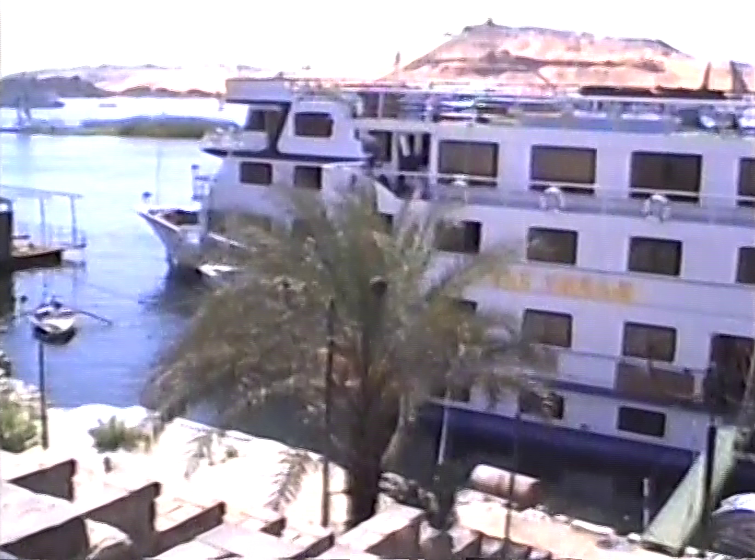 The ship we would cruise the Nile by over the next couple of days
The ship we would cruise the Nile by over the next couple of days
Aswan is around 870 km south of Cairo and this is an important administrative, trade, industrial and educational centre of south Egypt. For us, however, it was vital that this was an important tourist hub because of the sites that can be visited in its surroundings, as well as because of the numerous Nile cruises. Our visit to Egypt also included a cruise to Luxor that took 3 days and that is a rather usual variant, although there is a possibility to travel between Aswan and Cairo by ship and that trip takes 3-4 weeks.
To start with, during our sightseeing tour, we could notice that, unlike Cairo, there was no traffic jam here. At least this is what it used to be like 20 years ago. How it is today – I do not know.
First we started to visit the dams in Aswan. In 1902, 5 km south of Aswan, the British built the Aswan Low Dam that was later expanded. While being on the mini-bus, we first drove over this dam.
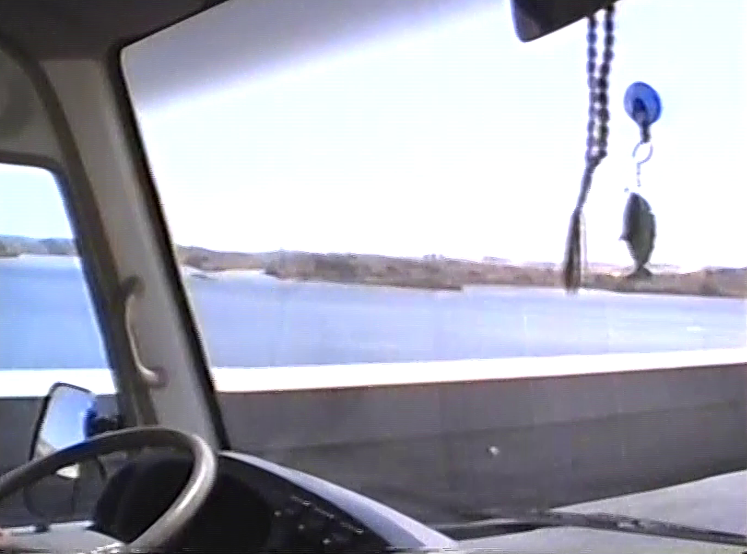 View at the reservoir behind the Aswan Low Dam
View at the reservoir behind the Aswan Low Dam
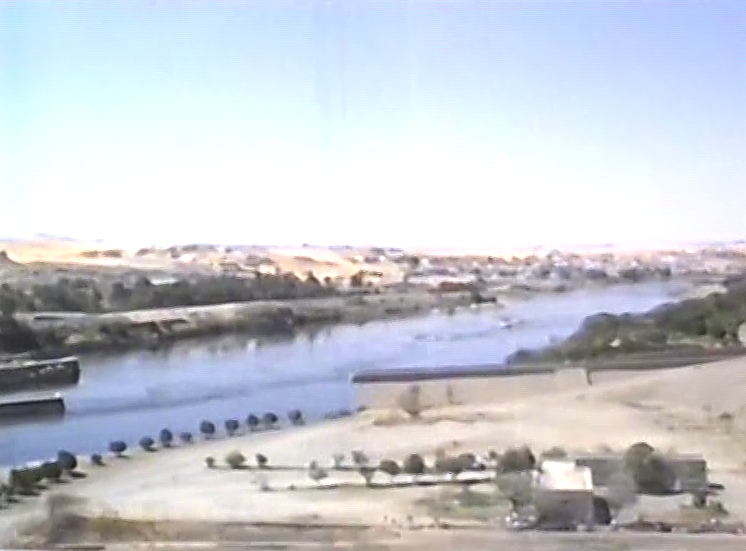 The Nile downstream from the Aswan Low Dam
The Nile downstream from the Aswan Low Dam
Then we also drove to the New Aswan Dam or the Aswan High Dam built around 11 km south of Aswan between 1960 and 1970. Namely, after the experience with the Aswan Low Dam and after the 1952 revolution, the Egyptians realised that they needed the same as what they already had, but significantly bigger. And so, in cooperation with the USSR, they constructed the Aswan High Dam behind which a huge reservoir, Lake Nasser, formed. The lake was named after Egyptian President Gamal Abdel Nasser during whose mandate the dam was built.
The main reasons for the construction of this gigantic dam were certainly linked to Egypt’s needs for electricity, as well as because of the whimsical nature of the Nile known for its annual flooding of the banks. It was precisely this characteristic of the river that enabled the development of a civilisation such as that of Ancient Egypt in its valley, but these seasonal inundations were rather unreliable and could be put under control precisely by a dam.
I find two consequences of this decision particularly interesting. First, many of the ancient Egyptian temples were inundated, but some, including the most important one among them – Abu Simbel – were saved. More about it a little later. The other important consequence is that, downstream from the dam, there are no more crocodiles in the Nile!
Having finished with the visit to the dams, we were brought to a docking station on the bank of the Nile or rather of a reservoir formed between the two dams. The reason was that we were about to visit an island in which there is the Philae Temple Complex.
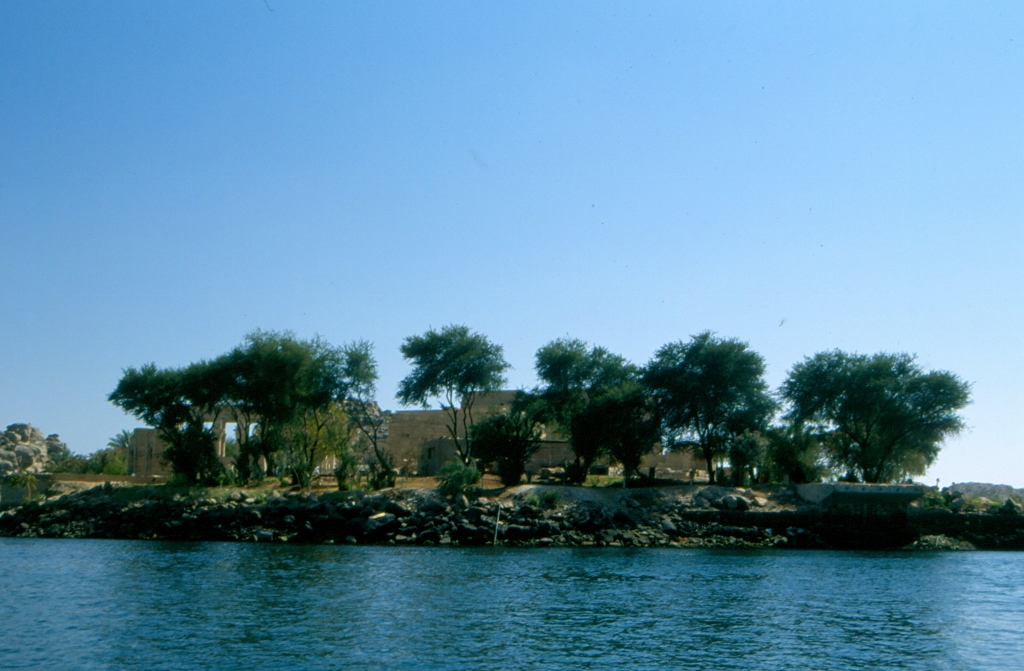 Getting close to the Philae Temple Complex
Getting close to the Philae Temple Complex
This temple complex used to be on the island of Philae before, but because of the construction of the Aswan High Dam in 1969, which would lead to the inundation, the temples were moved to the nearby Agilika Island.
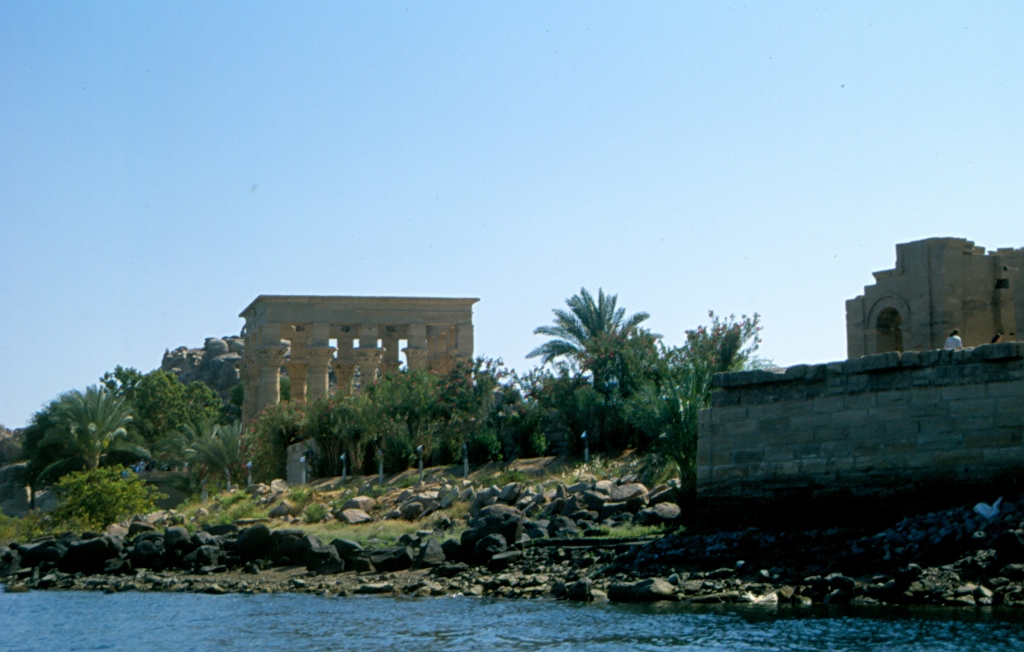 Getting close to Agilika Island
Getting close to Agilika Island
The main, central temple within the complex is dedicated to goddess Isis, protector of the kingdom, goddess of marriage and magic, etc. She was the supreme goddess in the Ancient Egyptian pantheon. She was the daughter of Geb (god of the earth) and Nut (goddess of the sky), and also a sister and wife of Osiris (god of fertility, agriculture, afterlife, underground, resurrection...). Her son was Horus, the god of the kingdom and the sky. The pharaohs represented the embodiment of god Horus on earth, which goes to say that he was an exceptionally important god. He is usually depicted as a human figure with a falcon head.
Still, although it is believed that the oldest temple here was built in the period from 8th to the 7th century BCE and the first temple to goddess Isis at the end of the 7th and the beginning of the 6th century BCE, more than two thirds of the structures within the complex were built during the Ptolemaic dynasty that ruled Egypt from 305 to 30 BCE. By the way, let me just mention that the founder of this dynasty, Ptolemy I Soter, was Macedonian by origin, as well as one of the generals and comrades of Alexander the Great during the latter’s campaign around Greece, Egypt and Asia, while the last ruler of this dynasty, as well as of entire Egypt was the famous – Cleopatra. After her, the Egyptian territories were ruled by the Romans.
The Philae Temple Complex continued to be an important religious centre during the Roman period as well, including also after the Christians came onto the historic scene.
I have already said that I was here in 2001. At that time I used slide films, which means that I took significantly fewer photos than today, so I don’t have enough illustrations, but I also had with me a video camera with which I filmed. These films have, meanwhile, gone through different forms of digitalisation, each one of which reduced the quality, so right now I can only offer the following short video clip:
So, when you start going towards the Temple of Isis, you first walk through a forecourt between two colonnades. On the east side, the colonnade consists of 16 pillars, while on the west side there are over 30. At the end of the colonnades there is the Temple of Isis.
Back in the day, I started here to learn about some basic elements of the Ancient Egyptian architecture, primarily as regards the construction of temples. The entrances into the temples were marked by pylons – monumental gates that consist of a doorway between two truncated pyramidal towers which resemble more a transverse wall through which you proceed further and which also serves as a notice board, since they are by the rule opulently and picturesquely decorated.
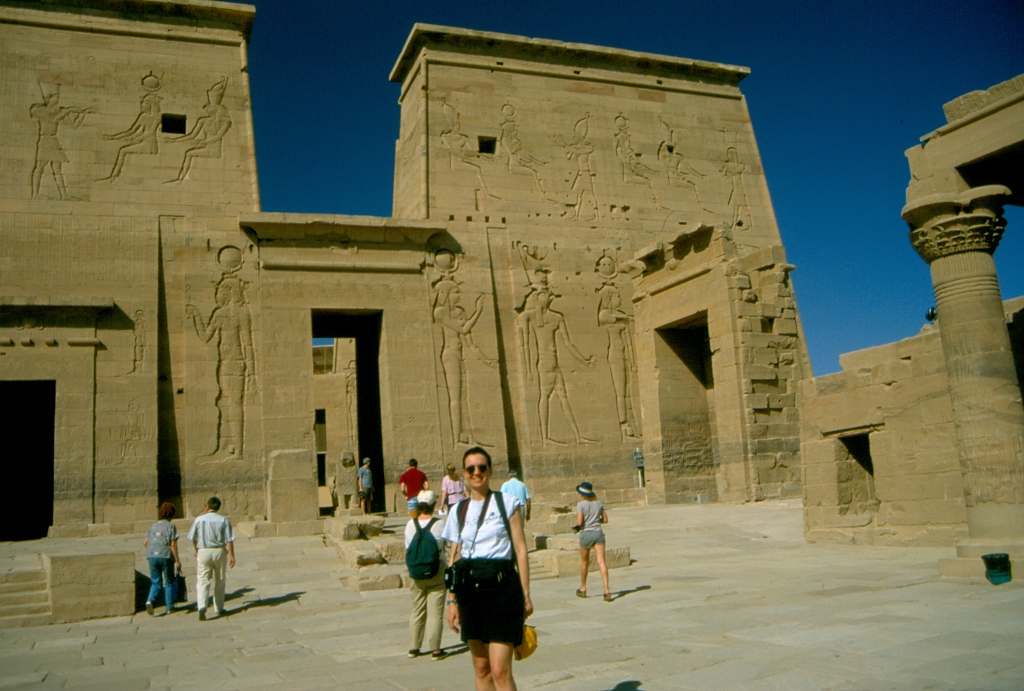 In front of the First Pylon within the Philae Temple Complex
In front of the First Pylon within the Philae Temple Complex
Once you walk through the First Pylon, you enter the inner courtyard also with colonnades (significantly smaller) on both sides and then there is the Second Pylon through which you directly enter the inner sanctum. In addition to the evident remains from the Ancient Egyptian period, one can also see elements that clearly demonstrate that Christians used to have a temple of their own here, since in one place there is a Christian stone altar placed on the side.
Apart from the Temple of Isis, the complex also comprises several other, smaller temples and one of the most striking is Trajan’s Kiosk.
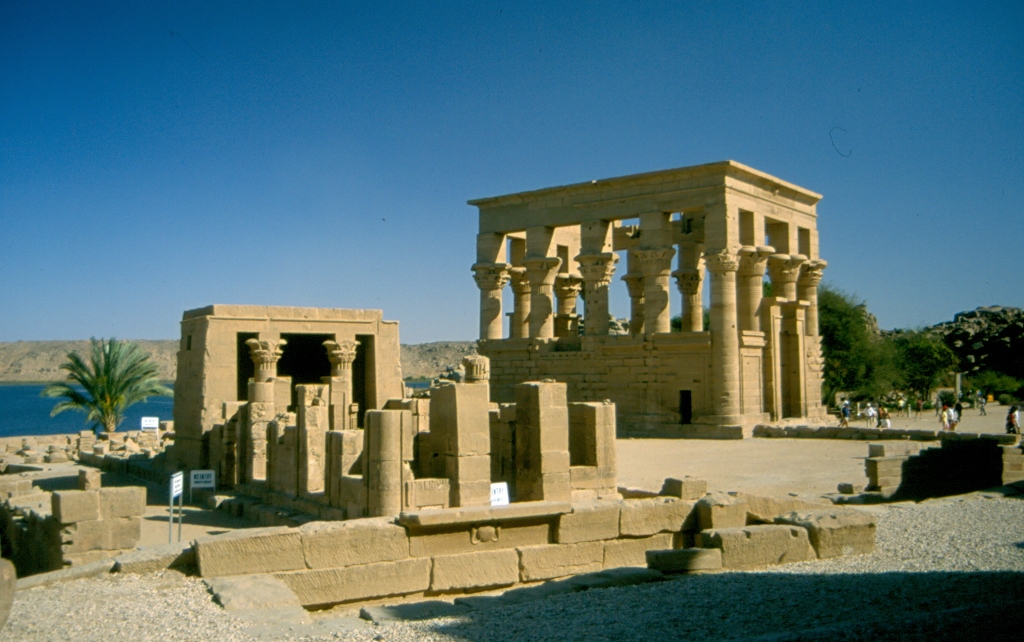 Trajan’s Kiosk
Trajan’s Kiosk
Although this unfinished temple is attributed to Roman Emperor Trajan (98-117), since his depictions as a pharaoh may be seen in some of the reliefs, most of the structure probably comes from the period of the reign of Emperor Augustus (27 BCE – 14 CE).
After this visit to the Philae Temple Complex, we returned by boat back to the mini-bus in order to continue with our sightseeing of the surroundings of Aswan.
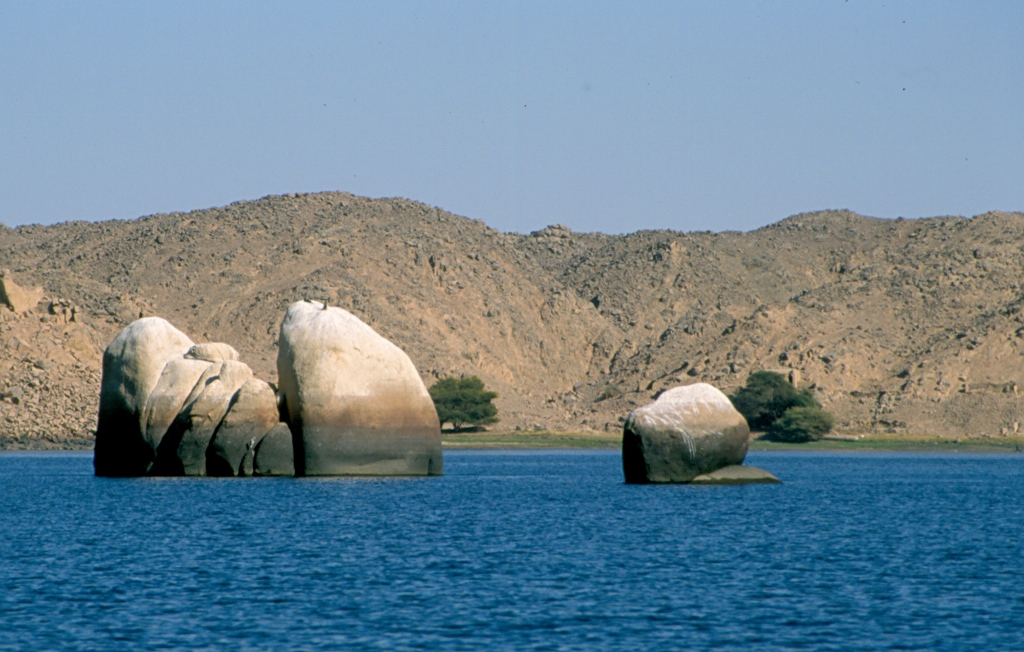 Reservoir between the two dams in Aswan
Reservoir between the two dams in Aswan
The next stop within our sightseeing tour was a visit to an unfinished obelisk that exists in one of the numerous quarries around Aswan. This is in fact the biggest known ancient obelisk, but, as I’ve said, it has never been finished, i.e., even today it is in a horizontal position and has not been fully detached from the rock out of which it was made.
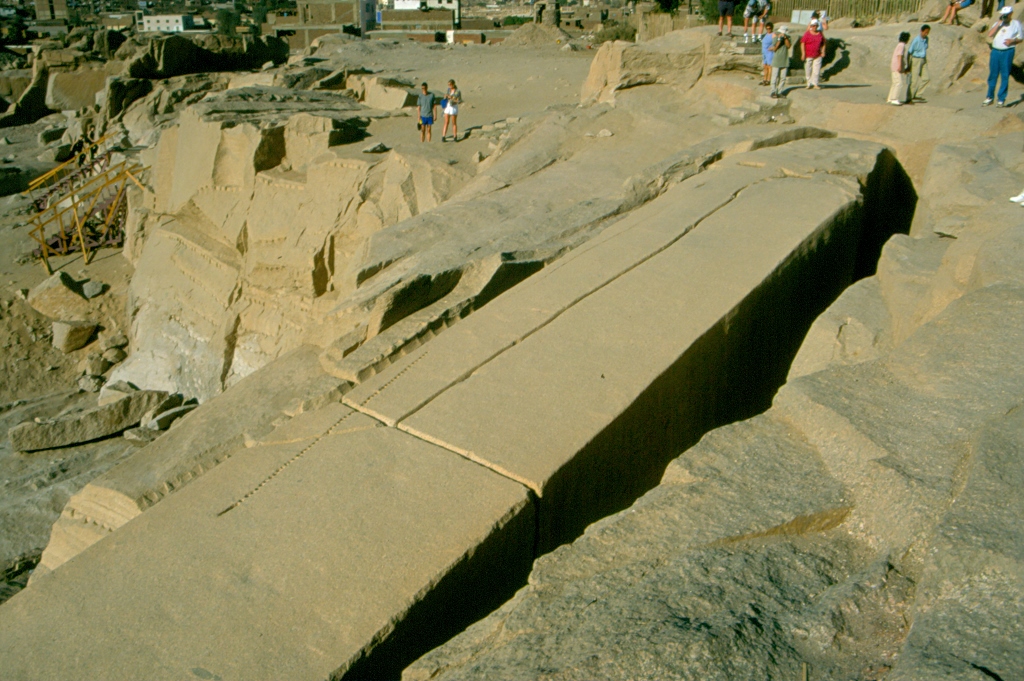 Unfinished obelisk in Aswan
Unfinished obelisk in Aswan
This obelisk was ordered by a female pharaoh Hatshepsut (1508-1458 BCE), but cracks appeared during the production and then the whole project was abandoned. If it had been completed, it would have been by a third higher than the other Ancient Egyptian obelisks, i.e., it would have been around 42 m tall and would have weighed around 1100 tonnes.
Since I’m mentioning obelisks, let me also say that regardless of the development of science and technology that makes people of the 21st century so proud, it is actually still unclear how the Ancient Egyptians: a) loaded the obelisks onto ships, b) how these ships sailed without sinking or capsizing on account of the weight or the possible instability of the obelisk, c) how these obelisks were unloaded from the ships and d) how they were erected without breaking in two. Many years ago I watched a documentary where modern scientists tried to prove their theories concerning this issue using obelisks that were a couple of metres high, but it all seemed quite unconvincing and by the end the scientists did not reach any definite conclusion.
When we finished with this visit of our sightseeing tour, the group went back to the ship, but I continued with our local guide in order to buy a small backpack, since the one I had on me simply got torn. That guide was very kind and later he took me for a sugarcane juice. I felt embarrassed to decline the invitation, but I did worry that I may have some problems with my stomach. However, in the end it all went well. We also walked by some shops with local sweets and soon we reached the bank of the Nile and I could return with my new backpack to the ship. However, the ship was actually docked a little farther away, the guide did not feel like accompanying me all the way there and could not simply just leave me out in the middle of the street, so he hailed a taxi, even paid for it, shoved me in and the taxi driver soon left me near my cruise ship.
We spent that evening quietly on the ship, docked by a bank of the Nile. From the terrace on the top of the ship I saw something that was very nicely lit on the other, western Nile bank. In the morning I found out that this was the Mausoleum of Aga Khan III who died in 1957. Aga Khan III was an Imam of one branch of the Shia Islam. The mausoleum that could be seen nicely during the day used to be open for tourist visits, but apparently no more.
There is another tourist attraction in Aswan and that is the Old Cataract Hotel. This is a famous luxury 5-star hotel from the times of the British colonial rule that was built by Thomas Cook (founder of a renowned British tour operator). Many celebrities have stayed at the hotel, including Agatha Christie who placed parts of her famous novel “Death on the Nile” precisely in this hotel. Since I had planned something very special for the next morning, my mom and I went to that hotel earlier that evening in order to have coffee there, as a kind of a treat. Luckily, Agatha Christie was not there, so there were no dead bodies to deal with.
So, the next morning was more or less free for the entire group, with the offer to go for a ride on the Nile by felucca, a traditional boat. However, my mom and I did in fact something way better and that was that I had arranged with the owner of the local tourist agency to get us an excursion to Abu Simbel. Since the distance between Aswan and Abu Simbel is around 300 km, it was clear that we could not do it during a morning travelling by coach or a van. No problems. We took a plane!
There are short excursions from Aswan to Abu Simbel that involve a flight one way, visit to the site for about an hour or two and then a flight back. This was precisely what my mom and I did on this occasion and it was absolutely magnificent.
When we landed at an airport near Abu Simbel, there were actually mini-buses waiting for us and then they took us to the site with the temples, which is around 5 km away from the airport. We had an hour and a half to visit two temples.
The archaeological site of Abu Simbel is situated in the very south of Egypt, around 40 km away from the land border with Sudan, in the region of Nubia. The site got its name after a nearby village and it consists of two magnificent temples carved in a rock. The venue where they can be seen today is not their original position. Actually, in 1968, the temples were cut into pieces and moved to a new location where they were re-assembled into a unique and harmonious form. The reason for the relocation – the construction of the Aswan High Dam and the creation of the Nasser reservoir with the consequential rising of the water level which would have completely inundated these temples in the place where they were originally made. The reason for preserving the temples – they are one of the most impressive monuments built by Ramesses II who is considered the greatest, most famous and most powerful pharaoh that Ancient Egypt ever had.
Ramesses II was born around 1303 BCE and he was one of the longest living pharaohs – he lived to be around 90 years old! He acceded to the throne in 1279 BCE, inheriting his father, Seti I. They both belong to the 19th dynasty. Ramesses II ruled until his death in 1213 BCE. Although he had several wives, the main one was Nefertari (not to be confused with Nefretiti) and with all of his wives Ramesses II had around 100 children. The mummified body of Pharaoh Ramesses II was buried in a tomb in the Valley of Kings, but was later moved to a royal cache where it was discovered in 1881. Today, it is located at the Egyptian Museum in Cairo.
During his long life and reign, Ramesses II led numerous military campaigns, but he was also one of the most prolific builders among the pharaohs.
And thus, around 1264 BCE, he started with the construction of two temples in Nubia that was controlled by Egypt at that time. The temples were finished around 1233 BCE and they were practically chiselled into the depth of a mountain, while in front of them there were huge rock high reliefs that have eventually become so recognisable. It is interesting that over time, the temples were almost completely buried under sand and were “discovered” in 1813. It was only in 1817 that the explorers reached the interior of the temples.
So, there are two temples here: the Great Temple dedicated to gods Amun, Ra-Horakhty and Ptah, as well as to the deification of Ramesses II himself, and the Small Temple dedicated to his wife Nefertari and goddess Hathor.
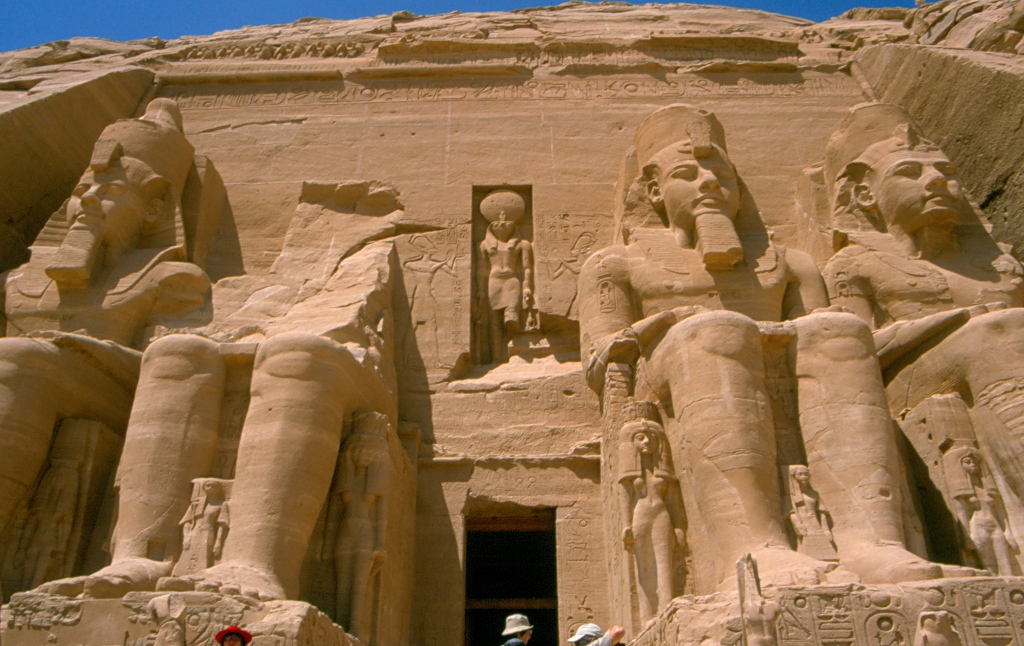 Abu Simbel, the Great Temple
Abu Simbel, the Great Temple
The Great Temple in Abu Simbel is considered the most beautiful temple not only among those built by Ramesses II, but also in the entire Ancient Egypt. Its entrance is decorated with colossal sitting statues of Ramesses II, each being 20 m high. While sitting on the throne, the pharaoh is wearing the double crown of Upper and Lower Egypt. Beside his legs there are statues of his chief wife, Nefertari, his mother, two of his first sons and first six daughters. A part of the sculpture of Ramesses II left of the entrance into the temple has been broken off in an earthquake and during the relocation of the temple these pieces were left in the same position in which they were found when the sand was first cleared from around the temple, i.e., in front of the feet of the sitting pharaoh.
In the middle of the front facade, above the entrance into the temple, in a niche, there is a bas-relief depicting god Ra-Horakhty. This god is actually a combination of gods Ra and Horus. Ra is the god of the Sun and Horus is the god of the sky, and so Ra-Horakhty was considered the god of the rising Sun. The disc above the head of the god clearly suggests the Sun and god Ra, while the falcon head is linked to god Horus. To the left and right there are carvings of the pharaoh expressing his adoration of Ra-Horakhty.
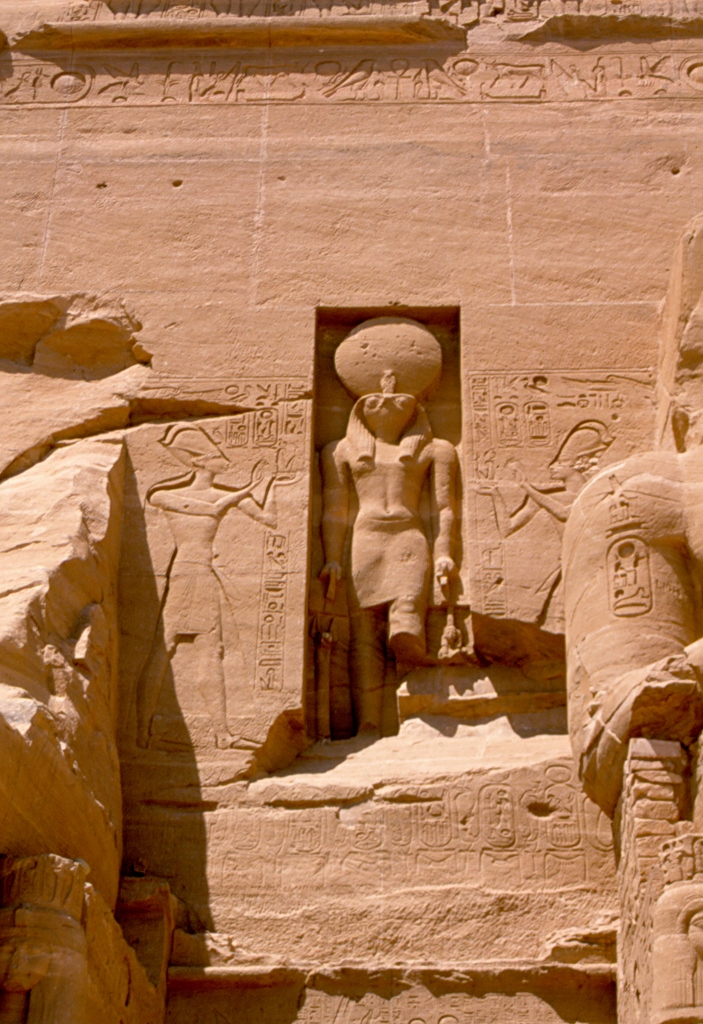 Abu Simbel, the Great Temple
Abu Simbel, the Great Temple
In the photo above, on the right upper arm of the pharaoh, on the right-hand side of the photo, you can see nicely a cartouche with the name of Ramesses II, clearly written in the hieroglyphic script. A cartouche is the name for an oval frame within which the name of a pharaoh is written and traditionally only the names of pharaohs were written in cartouches.
The whole facade of the Great Temple in Abu Simbel is around 33 m high and 38 m wide. On the top there is a frieze along which there are 22 baboons worshiping the rising Sun with their arms lifted up.
What I find truly amazing about the construction of these temples, apart from the jaw-dropping size and beauty, of course, is the precision in the execution. This is probably because I know nothing about stone carving, but what fascinates me is the impossibility of making a mistake because these were not some statues made in some other place and then brought here only once they had been made successfully (I’m not talking about the relocation of the temple, but about the original construction). It was probably quite inconceivable that some craftsman says to his foreman: “Oops, sorry, but I just chiselled off his nose!” No. There was no such thing. Everything was where it should be.
This also refers to the interior which is just as impressive, although quite different from the exterior.